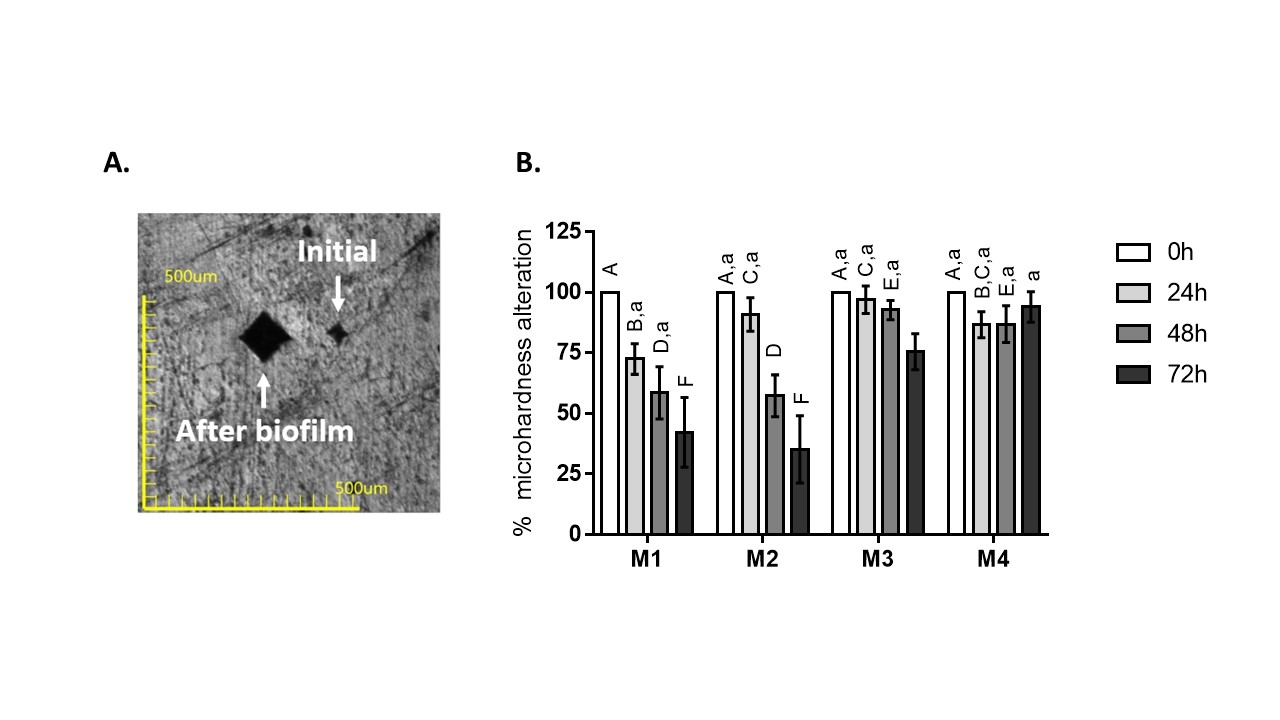IADR Abstract Archives
Are we representing dental caries with in vitro models?
Objectives: A challenge is to achieve models with a progressive (not drastic) transition of the oral microbiota going from commensal to pathogenic biofilm, to have a better understanding of dental caries as an ecological process. The present study aimed to create a model in which oral conditions were mimicked, and four factors were included: enamel as a substrate, a heterogeneous inoculum, an intermittent administration of sucrose and starch (simulating food intakes), and the time during which these factors interact to demineralize teeth surface as occur in dental caries effectively.
Methods: Seventy-two bovine enamel discs (Institutional Ethics Committee, CEUA: no 03/2018) sterilized by gamma irradiation (25 KGr) were used for the study where microcosm biofilms (inoculated with human saliva of nine volunteers, Institutional Ethics Committee, CAAE: 82750117.6.0000.5416) were grown in four experimental conditions: Feast and Famine (M1), Abundance and scarcity (M2), Three meals daily (M3), and Three meals plus two snacks daily (M4) (Figure 1). The experiments were carried out for three days. The pH of spent culture media was checked, and discs were removed after 24, 48 and 72h of biofilm growth to analyze the biofilms (biomass, total microbiota, mutans group streptococci) and the disc traits (microhardness and roughness). Variables were analyzed longitudinally for the four experimental groups. Data of all biofilm types were compared using two-way analysis of variance with Tuckey’s post-test to clarify whether exist a similar behavior inside and among biofilm models over time (α ≤ 0,05).
Results: Two major behaviors were observed: groups M1 and M2 promoted an acid environment, groups M3 and M4 maintained a pH closer to the neutral (Figure 2). The demineralization process was slower in the neutral groups (Figure 3); also, a greater increase of microbiota and biomass was observed over time.
Conclusions: In general, the groups M3 and M4 were better in mimicking the oral environment, having more characteristics similar to those found in vivo (lower pH drops, not drastic enamel demineralization, and possibly conservation of a more diverse microbiota). Thus, future studies should be carried out with additional analyses.
Methods: Seventy-two bovine enamel discs (Institutional Ethics Committee, CEUA: no 03/2018) sterilized by gamma irradiation (25 KGr) were used for the study where microcosm biofilms (inoculated with human saliva of nine volunteers, Institutional Ethics Committee, CAAE: 82750117.6.0000.5416) were grown in four experimental conditions: Feast and Famine (M1), Abundance and scarcity (M2), Three meals daily (M3), and Three meals plus two snacks daily (M4) (Figure 1). The experiments were carried out for three days. The pH of spent culture media was checked, and discs were removed after 24, 48 and 72h of biofilm growth to analyze the biofilms (biomass, total microbiota, mutans group streptococci) and the disc traits (microhardness and roughness). Variables were analyzed longitudinally for the four experimental groups. Data of all biofilm types were compared using two-way analysis of variance with Tuckey’s post-test to clarify whether exist a similar behavior inside and among biofilm models over time (α ≤ 0,05).
Results: Two major behaviors were observed: groups M1 and M2 promoted an acid environment, groups M3 and M4 maintained a pH closer to the neutral (Figure 2). The demineralization process was slower in the neutral groups (Figure 3); also, a greater increase of microbiota and biomass was observed over time.
Conclusions: In general, the groups M3 and M4 were better in mimicking the oral environment, having more characteristics similar to those found in vivo (lower pH drops, not drastic enamel demineralization, and possibly conservation of a more diverse microbiota). Thus, future studies should be carried out with additional analyses.



